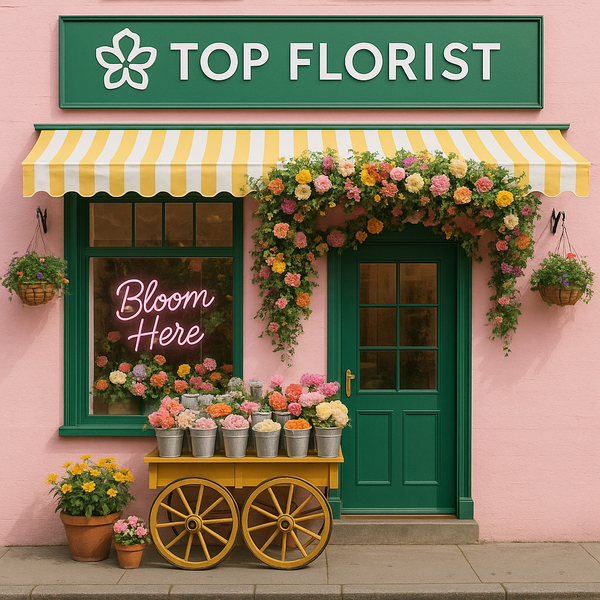
Petals & Particles: How Flowers Hack Light, Smell, and Time
Share
A nerdy (but warm) field guide from your local florists at Top Florist Woodlands.
1) Bee Vision & UV Roadmaps
Humans see petals as color. Bees see maps. Many flowers paint invisible bullseyes in UV—patterns that guide a bee straight to nectar like runway lights. Sunflowers, black-eyed susans, even certain roses hide these UV “nectar guides.” It’s not magic; it’s physics. Petal cells scatter light differently in the UV band, so bees (with UV-sensitive photoreceptors) read a high-contrast sign that we literally can’t.
Design tip: Mixed arrangements with high contrast (light centers, darker rims; or vice-versa) tend to feel lively because they echo the contrast bees follow in nature.
2) Aroma Physics: When Perfume Becomes a Pollinator Text
Fragrance is a moving target—literally. Scent molecules ride air currents, drift, collide, and break down with heat and light. Night-blooming flowers (think jasmine) release heavier, sweeter molecules when the air is cooler and more stable, increasing the odds those signals actually reach nighttime pollinators. Day-bloomers skew brighter and zippier because the sun and wind beat up delicate compounds. Science, but also kind of romantic.
- Warm room? Expect stronger but shorter-lived floral scent.
- Cool room? Softer projection, longer bloom-to-nose time.
- Drafts? They scramble scent plumes (and dry petals).
Care tip: Keep fragrant bouquets away from direct sun and vents to preserve their “aroma arc.”
3) Quantum-ish Color: Why Blues Are Rare (and Precious)
True blue pigments are botanical unicorns. Many “blue” petals are actually structural color, where microscopic petal textures bend and bounce light to create the appearance of blue. Chemistry joins the party too: anthocyanins shift hue with pH and metal ions, so a bloom can slide from magenta to indigo like a tiny mood ring. If that sounds a bit quantum, it’s because the light–matter dance happens way down at the molecular scale. (And, yes, I’m nerding out a little.)
Design tip: Pair rare blues with creamy whites and silvery foliage. The contrast lets the “structural blue” do its sparkle thing.
4) Petal Engineering: Velvet, Gloss, and the “Soft-Focus” Effect
Petal surfaces aren’t smooth wallpaper. Microscopic ridges can make petals look glossy (reflecting light like tiny mirrors) or matte (scattering it into a velvety glow). That’s why ranunculus photographs like silk and garden roses like satin. Your eye reads texture physics as luxury.
Photo tip: For phone shots, diffuse window light emphasizes matte petals. A small specular highlight (think nearby lamp, not direct glare) brings out glossy tulips.
5) Bloom Clocks: Timing Is a Survival Feature
Many flowers open and close on circadian schedules, syncing with pollinator routines and temperature. Morning-glories lean into sunrise; evening stocks hold scent for twilight. This isn’t just cute—it’s resource economics. The plant spends energy when returns are highest.
Entertaining tip: For a dinner party, add night-fragrant stems (stocks, tuberose) after the sun dips. Your dining room subtly changes mood as the bouquet “wakes up.”
6) Vase Life Chemistry: Sugars, Acids, and the Clean Water Rule
Cut flowers are still metabolizing. Give them clean water, a pinch of sugar (energy), a touch of acid (to keep xylem open), and an antimicrobial to slow bacterial sludge. That’s basically what a good floral preservative does. Skip it and stems spend more time fighting microbes than drinking.
- Start with a clean vase (soap, rinse, no residue).
- Trim stems at an angle (more intake area; avoid crushed xylem).
- Change water every 1–2 days. Cloudy water = lost time.
- Remove leaves below the waterline (bacteria love leaf soup).
7) Local Ecology, Local Beauty
In The Woodlands, humidity, heat, and air movement shape scent and vase life. We design with that in mind—choosing stems that keep their character in our climate and conditioning them the way a lab tech treats samples (but with nicer aprons).
Want the science-smart option? Ask for our “Designer’s Choice: Petals & Particles” and we’ll build an arrangement using high-contrast pollinator cues, complementary textures, and fragrance that actually performs in your space.
Quick FAQ
Why do some bouquets smell strong at first, then fade?
Warmer rooms accelerate evaporation and breakdown of volatile scent molecules. Cooler, stable air extends the fragrance curve.
Do blue flowers last less time?
Not because they’re blue—longevity depends on species and care. But many “blue” blooms rely on delicate pigments, so avoid direct sun to keep color true.
What’s the single best thing I can do?
Change the water. Clean water is the quiet hero of vase life.
